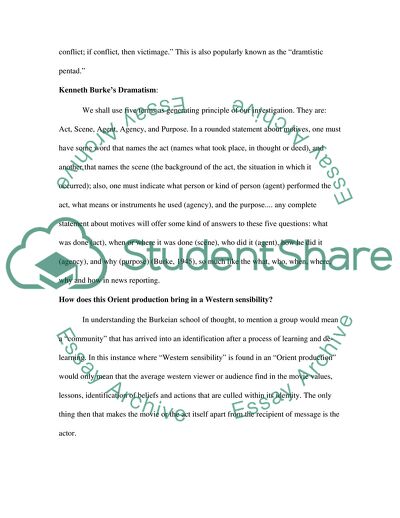
- Home
- Free Samples
- Premium Essays
- Editing Services
- Extra Tools
- Essay Writing Help
- About Us
- Studentshare
- Subjects
- Miscellaneous
- Theoretical Reflection Paper
Theoretical Reflection Paper - Essay Example

- Subject: Miscellaneous
- Type: Essay
- Level: Undergraduate
- Pages: 4 (1000 words)
- Downloads: 0
- Author: connellyviolett
Extract of sample "Theoretical Reflection Paper"
The usual run of the Kung-fu films emphasize action and usually have flimsy plots, and an almost non-existent portrayal of deep human emotions, but Crouching Tiger, Hidden Dragon is a beautiful, luscious, almost poetic adaptation from a wuxia novel by mainland Chinese writer Wang Du-lu. This essay shall discuss the communication elements undertaken in the movie that made it a symbolic rhetoric that helped the western audience understand what went on in the movie’s plot, and why these things happened, in Kenneth Burke’s line of opinion.
To understand its appeal for the Western audiences, we define and analyze the movie in terms of Kenneth Burkes precepts of dramatism and the five terms that he believed is capable of defining all human action: “If action, then drama; if drama, then conflict; if conflict, then victimage.” This is also popularly known as the “dramtistic pentad.” We shall use five terms as generating principle of our investigation. They are: Act, Scene, Agent, Agency, and Purpose. In a rounded statement about motives, one must have some word that names the act (names what took place, in thought or deed), and another that names the scene (the background of the act, the situation in which it occurred); also, one must indicate what person or kind of person (agent) performed the act, what means or instruments he used (agency), and the purpose.. any complete statement about motives will offer some kind of answers to these five questions: what was done (act), when or where it was done (scene), who did it (agent), how he did it (agency), and why (purpose) (Burke, 1945), so much like the what, who, when, where, why and how in news reporting.
In understanding the Burkeian school of thought, to mention a group would mean a “community” that has arrived into an identification after a process of learning and de-learning. In this instance where “Western sensibility” is found in an “Orient
...Download file to see next pages Read MoreCHECK THESE SAMPLES OF Theoretical Reflection Paper
Reflection on the Subject Teaching Session
Reflection using Gibbs model
Reflective Practice In Education
Reflective Practices in Organizations Enhance Performance
Learning and Consideration of Cognitive Behavioural Therapy Application
The Health Profession as One of the Most Fulfilling Professions
Element of Design of Excel Exhibition Centre
Reflection on Learning Using Theory

- TERMS & CONDITIONS
- PRIVACY POLICY
- COOKIES POLICY